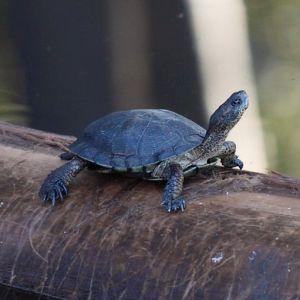SOUTHWESTERN POND TURTLE
Emys pallida
The southwestern pond turtle historically ranges from Baja California to the San Francisco Bay. It occurs from Chino Hills State Park in Aliso Creek from Banie Canyon to the confluence with the Santa Ana River and other locations. This species is scarce primary due to historical collections, habitat loss and degradation.
The southwestern pond turtle occurs in aquatic habitat consisting of ponds, lakes, marshes, rivers, streams and irrigation ditches. They bask on logs, rocks, and shorelines. They prefer areas with slow moving water but areas that are deep enough to evade predators. Southwestern pond turtle are omnivorous; adults eat insects, fish, amphibian eggs and tadpoles and aquatic plants. Hatchlings feed on zooplankton.

| Life Stage/Activity Period | Jan | Feb | Mar | Apr | May | Jun | Jul | Aug | Sep | Oct | Nov | Dec |
|---|---|---|---|---|---|---|---|---|---|---|---|---|
| Hibernation | ||||||||||||
| Breeding | ||||||||||||
| Hatchling Emergence |
See a map of the modeled species habitat distribution
Historically the southwestern pond turtle was collected for food which led to large declines. Current threats include habitat degradation, and the introduction of nonnative species, such as bullfrogs and largemouth bass, which eat hatchlings and juveniles. Management includes habitat protection and enhancement, and the removal of nonnative predators.
How you can help: Please don’t release unwanted pets, such as bullfrogs, into natural areas as they prey on species such as the pond turtle.
